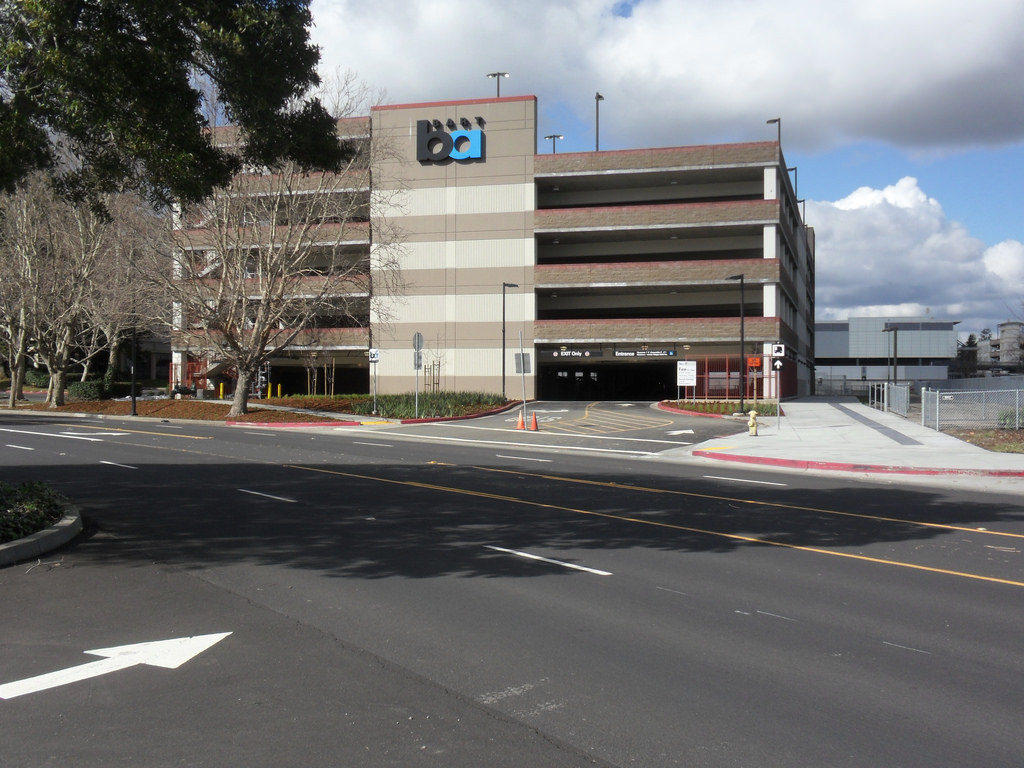Last year, BART rejected a proposal to build a parking structure at its Dublin-Pleasanton station, instead coming up with strategies to provide the same amount of parking for less money while encouraging bike, walk, and transit trips to the station. The alternative strategies were in keeping with new state, regional, and BART's own environmental and climate goals.
But some were not pleased. Assemblymember Catharine Baker and County Supervisor Scott Haggerty insisted that a new parking structure, which would provide less than a third of the parking spaces on the station's current waitlist, was absolutely necessary. Baker said she could get $20 million for the project—which is expected to cost about $30 million plus—and she did not like BART's substitute strategies.
So the Alameda County General Services Agency applied for a grant from the California Transit and Intercity Capital Rail Program (TIRCP) to build a structure on a county-owned parcel next to the BART station. The Alameda GSA doesn't have anything to do with transit. So it got the Livermore Amador Valley Transit Authority (LAVTA) to sign on as the responsible transit agency.
But LAVTA gains nothing from a parking structure at BART. Its core function is to provide a connection between BART and other places in Livermore.
The TIRCP, which is funded by cap-and-trade revenue as well as S.B. 1 gas tax money, is supposed to be used for “transformative capital improvements that modernize California’s intercity ... transit systems” to reduce greenhouse gas emissions and “expand and improve rail service to increase ridership.”
But among the list of grantees announced last week this one stands out like a sore thumb. It has a name that sounds good: “Dublin/Pleasanton Capacity Improvement and Congestion Reduction Program.” A more accurate name could be “More Car Storage and Inducements to Drive.” Does parking "modernize" transit?
The project claims, as one can guess from its title, to reduce congestion (not a goal of the TIRCP, by the way) and to reduce greenhouse gas emissions—presumably by encouraging freeway drivers to pull off and park at the BART station, instead of driving all the way to their destinations. It also admits it won't serve any disadvantaged communities, as called for by A.B. 1550—although the grant includes funding “to identify opportunities to enhance benefits to such communities.” In other words, that pesky detail will be figured out later.
The structure, says the grant, “will include electric vehicle charging stations with preferred parking for vanpools to maximize utilization” and “will be built with convertible uses in mind.” That last is in response to claims that autonomous vehicles and ride-hail and who knows what new thing (electric bikes?) will render parking altogether moot in the future, the idea being that when that comes to pass, the structure could be turned into housing or office space.
Even though housing for people is a little more desperately needed right now than housing for cars.

BART's alternative plan, for way less than the $30 million the structure will cost, would have improved bike and pedestrian station access, formalized parking sharing at existing lots, and added car lifts, stacked parking, and attendants to make more spaces available in existing parking structures.
“I think BART for the first time really stepped back and got creative about how we can address parking demand at our stations without having the huge cost of a parking garage that locks us into the cost of parking for decades to come,” said BART board director Rebecca Saltzman. “I think we had a very good plan that met in the middle and addressed parking demands more quickly, for less money.”
“It's a shame that we can't move forward with what could have been a model for the future,” she said. “It's disappointing that people in the county wanted to move forward with this project.”
To recap:
- BART didn't want to build a parking structure, and came up with a strong alternative strategy more aligned with state, regional, and agency environmental goals
- Assemblymember Baker really wanted that parking structure, and could get $20 million from the state for it
- Parking is not an appropriate use of TIRCP funds
- The agency that applied for the grant does not provide transit; the transit agency that signed on to the grant will not benefit from the parking structure
- The county of Alameda, which owns the lot where the parking structure will be built, may be on the hook for the remaining $10-plus million to build it
- The county-owned lot will not be developed in a way that will provide the county with tax revenue
How did this all happen? Assemblymember Baker was one of the few Republicans who agreed to vote for the extension of cap-and-trade last year--although she did not vote in favor of S.B. 1, the gas tax. At the BART meeting last August to discuss the parking structure, board members were uncertain where her promised $20 million was coming from and whether it was restricted to a parking structure or could be used for something else. But they knew one thing:
Both Saltzman and [BART] General Manager Grace Crunican quoted recent conversations they had with CalSTA Secretary Brian Kelly, who cautioned them that use of the $20 million was entirely at the discretion of Assemblymember Baker.
Assemblymember Baker insists that “This is better than any option BART ever could have provided,” according to the Pleasanton Weekly. “This structure will have more spaces, and cost less money than what BART ever considered doing, and will be a state-of the-art structure that can be used for commercial purposes or housing should the need for parking someday subside.”






